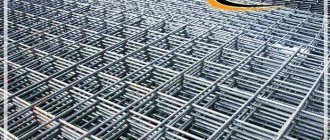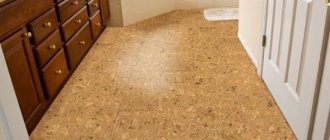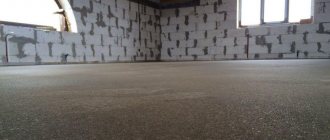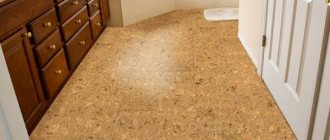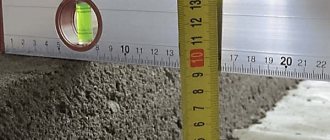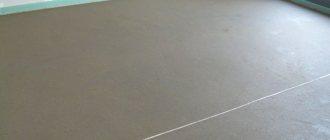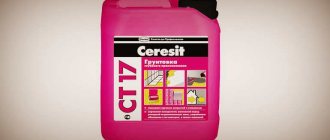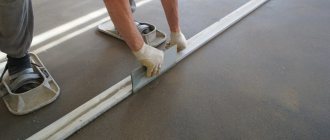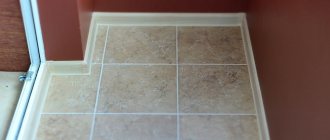Many years of practice show that concrete or cement-sand screed is the most reliable floor structure. The only thing better than this is a reinforced floor screed. Concrete is considered a brittle material and has no particular tensile or bending strength. And if in residential premises, on reinforced concrete floors, the concrete screed does not need reinforcement, then in factory workshops or in a warehouse, garage, the floor bases experience significant loads. Such floors need to be strengthened.
When is reinforcement necessary?
A reinforced screed is essentially a type of reinforced concrete product that can withstand various types of loads. The fittings included in the design are intended for:
- protecting floors from cracks and microcracks during operation;
- subsidence of the concrete base;
- extending the life of the floor.
A cracked screed is a consequence of non-compliance with concreting technology and refusal of reinforcement.
In a residential area, a screed is a 4-8 cm layer of sand-cement mortar that levels reinforced concrete floor slabs. In turn, the slabs do not allow loads that deform the screed; they take them upon themselves.
However, if thermal insulation material (mineral boards, polystyrene foam, extruded polystyrene foam) is laid on reinforced concrete floors, reinforcing the floors becomes necessary.
Reinforcement of floor screed in an apartment or house is carried out under fireplaces, stoves, and expected areas of high load. Also in residential premises it is necessary to reinforce the screed with a thickness of more than 50mm.
Advantages of floating screeds
Floating screeds are simple to install and have a number of advantages over other types of leveling coatings:
- good heat and sound insulation due to the use of porous materials;
- Reduced floor vibration;
- No deformation expansion and cracking;
- Increased depreciation, which has a beneficial effect on the musculoskeletal system;
- Smoothing of uneven bases;
- Reducing the load on the floor.
In floating screeds, the leveling coatings do not bind to the surface of the floors and to the walls of the building, and, accordingly, do not transfer vibrations and mechanical loads to them.
Screed mesh – metal
In construction, structures are traditionally reinforced with mesh elements. These could be the following meshes:
- galvanized metal used in road construction. In private housing construction, owners use chain-link or plaster mesh as reinforcement, which does its job well;
- plastic, polymer;
- fiberglass mesh;
- reinforced with fiberglass made of polypropylene, basalt, metal, glass.
The most successful option for strengthening the screed is considered to be reinforcement with metal mesh. For individual construction, this kind of reinforcement is a guarantee of the service of the cement floor for many years.
Metal mesh with a cell of 100 by 100 mm, for reinforcing the floor screed.
Fiberglass and polymer meshes are inferior in strength to metal ones. Therefore, they are more often used in private housing construction, public buildings, and rooms where there is no heavy load on the floors.
Bulk fibers - fiber, are added to the solution during mixing. This method of strengthening the screed guarantees against the formation of shrinkage cracks and microcracks. Fiber increases the impact resistance of the floor, but cannot provide resistance to bending and tensile loads.
Reinforcement for strengthening the screed
The reinforcement bars are connected by spot welding or twisted wire using a hook for tying the reinforcement. As a rule, steel reinforcement of class A400 is used as rods, the diameter of which is calculated depending on the load on the concrete or cement-sand reinforced screed. The most popular for welding (twisting) rods is reinforcement with a diameter of 8 to 12 mm. Cells, depending on the diameter of the reinforcement and the calculated loads on the floors, have sizes from 50 x 50mm to 250 x 250mm.
Reinforcing mesh is effective for constructing floors on soil, crushed stone, and expanded clay. In some cases, when reinforced floors are required, SNiPs recommend laying mesh in two layers. The same SNiPs require the placement of a mesh in the thickness of concrete to protect the reinforcement from corrosion.
Types of floating screeds
Floating screeds are available in dry, wet and semi-dry types.
The main condition is that they must be insulated by enclosing partitions, walls and floors.
The design of dry screeds consists of a rigid base made of gypsum fiber board, moisture-resistant plywood, OSB or special gypsum boards produced by Knauf, equipped with locking joints, laid on insulation.
Figure 2. Dry screed design
Semi-dry - made by mechanized method from sand, cement, reinforcing fiber and a minimal amount of liquid.
Wet - cement-sand screed reinforced with steel mesh.
When choosing a screed technology, take into account the operating conditions and purpose of the premises.
Sequence of flooring
In order for indoor floors to serve for a long time and reliably, you need to carefully perform each stage of work:
- Prepare the surface of any base properly - clean it from dirt and debris.
- If the base is an old concrete surface, you need to open up the cracks, clean them and fill them with liquid mortar.
- If provided for in the project, waterproofing and thermal insulation are installed.
- Using a water level, the floor level is marked on the walls of the room.
- Plastic clamps for the reinforcement are laid out, or pads are made from the solution for the mesh to ensure its position in the thickness of the concrete.
- A mesh is laid on the clamps with sheets overlapping by 1-2 cells.
- Next, beacons are installed - boards, slats or guides for factory-made plaster. The distance between the beacons should be 10-20 cm less than the length of the rule.
- Concrete or mortar is poured between the beacons.
- When the screed has set, the beacons, if they were bars or boards, are removed, and the holes are sealed with concrete or mortar.
To prevent the reinforced fresh screed from drying out unevenly in places, it needs to be watered for several days and covered with plastic wrap.
Some tips and tricks
To ensure that the installation of the screed goes as smoothly as possible and the quality of work is at its best, it is recommended to take into account several installation rules.
- The thickness of the reinforced screed should not be less than 6 cm.
- The complete drying time for the concrete mixture is about 28 days. There is no need to disturb the material or lay down the finishing before.
- A layer of expanded clay or cement mortar is laid before pouring the screed so that the mesh remains directly in the screed layer itself.
- If the weather is hot, then the screed should be covered with plastic film during the drying period.
- All oil stains, as well as traces of paint, are removed from both the subfloor and the mesh. This will ensure maximum adhesion of the concrete mixture to other materials.
- The reinforcing mesh must be completely covered with mortar.
Laying reinforcing mesh for screed
Reinforced screed is an excellent way to create a durable and reliable subfloor, on which a finishing layer can subsequently be safely laid. The cost of this type of base is no higher than a regular one, so you can easily afford to spend money on a reinforcing mesh, which will provide peace of mind for the integrity and quality of the screed layer.
Non-metallic materials for floor reinforcement
Designers, after calculating the loads on the floors, willingly include plastic mesh for reinforcement in the documentation. But this material is used only for reinforcing screeds with a small load, for example, when installing heated floors or self-leveling floors in residential premises, offices, restaurants, and other public places.
They have plastic products and some quite significant advantages:
- Light weight, which is convenient for transportation and storage. They are easy to cut and install.
- High elasticity compared to metal mesh allows for better stretching in the event of building shrinkage, which prevents the appearance of cracks on the floor surface.
- Plastic fittings are not afraid of aggressive environments and corrosion.
- High elasticity and tensile strength make this material popular in new buildings.
- Low cost.
The technology for installing a floor in an apartment using polypropylene mesh is not fundamentally different from installing a screed with metal reinforcement. The difference can be considered that the plastic mesh does not require supporting elements. A minimum thickness of concrete or mortar is poured onto the prepared base, and a plastic mesh is placed directly on it. Next - beacons, filling, as with any type of screed.
Features of the technology
Reinforcement is a method of increasing the load-bearing capacity of a structure. Particles of more durable raw materials than the main building material are introduced into the surface. Most often, concrete is reinforced, which collapses when dried out, under heavy loads or due to sudden changes in temperature (humidity).
Reinforced screed differs from conventional screed by the presence of additional reinforcing parts inside. The reinforcing structure is ideal for rooms with uneven floors. Using the technology, it is possible to quickly and easily distribute the solution over the surface, and the inclusions will withstand the mass of building material without deformation.
The floor is reinforced with a screed to prevent subsidence under the elastic base. Reinforcement is not necessary for hard surfaces or thin (up to 6 cm) screed. Technology is required for:
- insulation of any type;
- soil prone to swelling (sand, gravel);
- hydro-heat and sound insulation;
- rough floor along joists.
Additional elements take on the compressive effect, protecting the concrete from natural shrinkage. If a floating or composite structure is made on the floor, then reinforcement must be used. The inclusions neutralize bending loads.
Fiberglass mesh
Reinforcement of floor screed is possible only with impregnated fiberglass mesh. Impregnation allows them to withstand the effects of the alkaline environment formed in the thickness of concrete.
The material for the reinforcement is threads containing aluminoborosilicate glass. The performance qualities, characteristics, and scope of application are the same as those of polypropylene mesh.
The downside, although insignificant, is that it is undesirable to use fiberglass in rooms with a possible risk of fire. The critical temperature for fiberglass reinforcement is 150°C.
Fiber fiber
The principle of using fiber as reinforcement for screeds is significantly different from mesh reinforcement.
Fiber - fibers of basalt, glass, polypropylene, metal, in dry form are added to the ingredients of mortar or concrete. When the floor hardens, the fiber gives the effect of a durable monolith, protects the floor surface well from microcracks, but will not save you from significant mechanical impact.
The fiber-reinforced screed is laid and leveled along the beacons, just like concrete or mortar for other types of reinforcement.
If fiber is used simultaneously with metal or polypropylene mesh, a super durable coating is obtained.
When working with fiber, you need to add it in small portions to the mortar mixture, waiting until the fibers are completely distributed in a concrete mixer or other container. If you add all of it at the same time, the fiber can bunch up into a shapeless lump.
Warm floor
When installing heated floors, reinforcement with cement-sand or concrete screed is mandatory . This is required by SNiPs, and even an individual developer must understand the need for the operation.
The fact is that for a heated floor to work effectively, you need reliable thermal insulation. Most often these are polystyrene foam boards. Heating elements are placed on this layer and filled with solution. Such floors are susceptible to temperature changes, and the reinforcing elements prevent the appearance of cracks on the surface.
A heated floor screed without reinforcement will not last long. The best option for strengthening heated floors would be combined reinforcement - metal or polypropylene mesh and fiber.
A flat floor is a prerequisite for high-quality installation of all modern coatings - laminate, parquet boards, linoleum, ceramic tiles. The concrete finishing coating is excellent for leveling the base. But concrete and mortar are considered fragile building materials and can be destroyed under the influence of mechanical loads and temperature changes. The last one is an important question. Modern technologies make it possible to install heated floors by introducing heating elements into the thickness of concrete and “hiding” utility lines.
Reinforcing the screed with metal, plastic, fiber improves the performance of the concrete floor, it becomes resistant to various types of influences. The reinforcement prevents the formation of cracks, the surface is smooth and even, and resists thermal loads.
How to choose?
Since reinforcement makes it possible to reduce the thickness of the screed and the consumption of concrete, funds are freed up in the estimate for the purchase of more expensive reinforcement; in general, the amount of the estimate will not change.
The choice of material for reinforcement depends on the planned type of screed, type of finishing coating, and budget, since prices for materials vary greatly. Different types of screeds require appropriate reinforcement, but it is also possible to combine different methods. There are three main groups:
Classic, when the screed adheres to the rough base and is poured onto it without separating films. Self-leveling floors are also classified as classic. Such screeds can be reinforced with all types of materials, combined with mixing fiber into the solution.
- A monolithic or so-called interlocking screed is used when the finished room will contain heavy pieces of furniture or equipment, partitions, or other significant load. This screed weighs up to 150 kg per square meter. A steel welded or bonded reinforcement grid is selected for it; cards or rods are connected into a single rigid frame, laid on stands in two layers and form a monolith with concrete. It is used for workshops, warehouses, shopping centers, large offices.
- Floating, which is located on a dividing pad made of layers of insulation, on the ground, a layer of sand or gravel. This type of screed should be chosen for apartments in high-rise buildings, where heat, hydro, and sound insulators are required to be laid. If you are planning a finishing coating - laminate, parquet boards or linoleum, under tiles, then a floating screed is suitable, but is not used for parquet. It is used for heated floors, for quick or low-budget repairs. According to construction SNiPs, a floating screed must be reinforced. For this purpose, both metal and lighter plastic and fiberglass reinforcing mesh and various types of fiber fibers are used.
There are several more rules for purchasing and using reinforcing materials:
- For thin, lightweight ties, it is recommended to choose fiberglass and polypropylene fiber. For aggressive environments - basalt, for loaded floors - metal.
- When purchasing fiberglass mesh, you should check the alkali resistance. The SSP-95 and SSSDor-330 brands have these properties; they do not collapse in the concrete layer.
- To reinforce dry and semi-dry screeds produced using an automated (mechanized) method, bulk fiber elements are usually used. The result is not inferior in strength to reinforcement of the screed with steel mesh.
- You should carefully examine the junctions of the cells; sometimes they are welded one at a time, which significantly reduces their quality.
- Purchase mesh without tears, oil or other stains, or visible defects.
- For the foundation, masonry mesh GOST 23279-2012 is purchased.
Both experienced construction specialists and novice repairmen note the obvious benefits and benefits of using reinforcing materials at all stages of the work performed. Reinforced floors, which last a long time and do not deform, receive excellent reviews.
